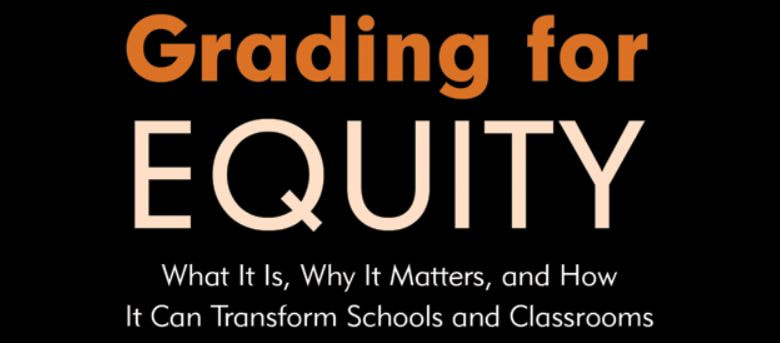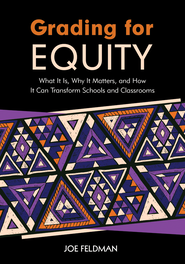Grading for Equity (Part 4) - Homework & Classwork
(Bias-Resistant Grading Practices)
So this post is about homework and classwork. Of all the items in Joe Feldman’s Grading for Equity book, Chapter 10 has led me to commit to one of the biggest changes in grading I plan on making next school year. For 20 years I’ve included homework and classwork scores, at least in some form, in my grading. That alone will make this long-overdue change difficult for me, but what will replace those scores will also be challenging. Here’s how he convinced me to once again reevaluate and recommit to a changed strategy…
Over the past few years I’ve given far less traditional physics homework in my physics classes as I’ve been using a ‘flipped’ classroom model. Nonetheless, many of the issues Feldman writes about concerning homework are equally valid for class and lab work--especially in noisy and crowded classrooms with a single teacher. So while I’ll use the word ‘homework,’ for me, I’m also thinking about work done by my students in class as well--their ‘classwork.’
In any case, how do teachers, including me, typically include homework in a student’s grade? Most often we grade the homework for correctness or alternatively for whether or not a student completed or attempted the work. Starting with his ‘Driving Principle,’ “Grades should be based on valid evidence of a student’s content knowledge, and not based on evidence that is likely to be corrupted by a teacher’s implicit bias or reflect a student’s environment” (p. 128), Feldman discusses concerns with each way of including homework in student grades.
When less than perfect homework scores are included in the final grade calculation, they don’t accurately represent student growth or knowledge and this violates the Driving Principle. Feldman writes, “Even though students made mistakes when learning the concept--exactly what we wanted them to do--grades that should reflect content mastery are lowered, rendering an inaccurate description of their levels of competence” (p. 129). Additionally, grading for correctness can negatively impact students who are a bit weaker by making them more hesitant in completing an assignment for fear of not being able to do so correctly. This can lead teachers to make incorrect assumptions about students and also prevents teachers from correctly diagnosing and addressing student difficulties.
Recognizing the problem with grading homework for correctness, some teachers instead award grades for attempting the homework. Feldman writes, “Unfortunately, this policy puts teachers on a different path toward the same dead end. Including homework in the grade with this approach continues to result in grades that are based on inaccurate and invalid information and inequitably privileges certain students” (p. 130). Grades still aren’t based on valid evidence. Some students who consistently submit homework may still perform poorly on summative assessment but their homework inaccurately inflates their grade. Conversely, students who perform well on summative assessments without submitting homework receive lower grades that are also inaccurate.
Grading homework often incentivizes student behaviors and attitudes that are not wanted. Feldman points out that many students depend on homework grades to boost their overall grades and compensate for low summative scores. This dependence leads them to seek assistance from caregivers, older siblings, and friends. This assistance can lead to increasing learning, but often, due to limitations of time and other factors, it's not actually helpful in student learning. Copying of work is a real and substantial issue in many classes and Feldman spends time quoting many students on the reasons why they chose to copy work. He also references research supporting the idea that executive functioning is a struggle for all teenagers: “It’s not easy for teenagers, in the midst of rapid physical, mental, psychological, and social changes, to always be organized and remember to do, and how to do, every assignment for every class each day. When every homework assignment is included in the grade, perfectly predictable mistakes are treated as unacceptable and can compel students to correct these mistakes by copying” (p. 136).
Additional conditions that lead a decrease in executive function and students to making unhelpful decisions like choosing to copy include:
Feldman also points out that stress for teenagers is common and can be exacerbated by things like parental pressure to excel, the death of a loved one, and anxiety based on family issues like parental disagreements, divorce, or job loss: “Brain research confirms that when we are stressed, our cognitive capacity decreases… We also know that some groups of students as a group experience more stress than others, further inhibiting executive functioning and higher-order thinking” (p. 135). Examples include those growing up in poverty, violent communities, and homeless.
In some cases homework is viewed as a compliance measure for students that “perpetuates inequalities and the achievement gap” (p. 137). Think of an EL student who isn’t completing his homework because he literally doesn’t understand what is being asked of him, or the student who must spend hours on crowded public transit to pick up a younger sibling from school and make their way home each day. “For students whose lives are chaotic or who need more supports than are available to them,” Feldman writes, “their not doing homework is not a problem of motivation” (p. 138).
How do we then reframe homework for students and teachers? Feldman goes on to discuss seven benefits of not adding or subtracting points for homework in students’ grades. Since this post is already a long one, I’ll try to be brief in my description, but would encourage you to read more in his book, of course.
So, if we aren’t including formative work like homework and classwork in students’ grades, that leaves summative assessments. Feldman points out that many teachers already recognize the importance of summative grades and often weight their grades toward summative assessments anyway. But this is not enough. He writes, “Equitable grading that is accurate and bias-resistant includes nothing other than a student’s summative assessment results” (p. 143).
Including only summative assessments in grades leads immediately to two concerns: 1) How do teachers approach assessments? and 2) How do we prevent the student stress we avoided by not counting homework from infecting the summative assessments?
Feldman’s response to the first question is that we must “ensure that our assessments are clearly measuring those standards and not the “noise” of confusing or biased tasks or unnecessarily challenging response forms” (p. 144). Our responsibility to make and give valid and accurate assessments has always been important, but if 100% of the students’ grades will be based on them, their importance is that much greater. Teachers need to offer different types of assessments and do so multiple times to triangulate a student’s performance.
For the second question, Feldman states that “equitable grading marries the emphasis of summative assessments with offering retake opportunities” (p. 144). When students have multiple opportunities to reassess, their stress is lowered and they can more easily focus on growth. Students need to know that one poor assessment is not the end of their learning but can be used to identify areas of needed improvement; retakes are a necessity in this system and I will have more to say about them in future posts.
Of course I doubt I’ll stop assigning classwork and homework while suggesting due dates to my students. Feldman agrees and even suggests that we record this data as well. He writes, “the quizzes, the classwork, the homework, coming on time, asking questions” are all still important. “Continue to enter it in the grade book, but in a category worth 0%...that information is likely related to students’ academic performance” (p. 145). Such data can help teachers in their conversations with teachers and students as they work to improve.
As a teacher I’ve thought about much of this before. I’ve known about standards based grading (SBG) for years. Why haven’t I adopted these practices before now? I was worried about the amount of work it would take for me to change--and the magnitude of the change. Feldman is reassuring: “Including only summative assessment performance in the grades doesn’t just free (and push) us to expand our repertoire of assessment and design strategies, it also allows (and requires) us to apply our professional judgement to every assessment result, ensuring that every score we incorporate into a student’s grade is an accurate reflection of her learning” (p. 143). This statement from Feldman encapsulates many of my feelings on the issue--the change is noble and worthy, but can I live up to it? Can I push and require myself to make the large changes necessary? I don’t know how it’s going to turn out, and there are likely to be some missteps, but the more I think about it, the more I’m willing to give it a go. I have great hope that if I free myself from the tediousness of grading and checking off daily assignments I can, as Feldman says, “focus on the craft of teaching and the assessment of learning.”
TLDR: Grades should be based solely on summative assessments, not formative ones.
Next up… About those retakes…
(Bias-Resistant Grading Practices)
So this post is about homework and classwork. Of all the items in Joe Feldman’s Grading for Equity book, Chapter 10 has led me to commit to one of the biggest changes in grading I plan on making next school year. For 20 years I’ve included homework and classwork scores, at least in some form, in my grading. That alone will make this long-overdue change difficult for me, but what will replace those scores will also be challenging. Here’s how he convinced me to once again reevaluate and recommit to a changed strategy…
Over the past few years I’ve given far less traditional physics homework in my physics classes as I’ve been using a ‘flipped’ classroom model. Nonetheless, many of the issues Feldman writes about concerning homework are equally valid for class and lab work--especially in noisy and crowded classrooms with a single teacher. So while I’ll use the word ‘homework,’ for me, I’m also thinking about work done by my students in class as well--their ‘classwork.’
In any case, how do teachers, including me, typically include homework in a student’s grade? Most often we grade the homework for correctness or alternatively for whether or not a student completed or attempted the work. Starting with his ‘Driving Principle,’ “Grades should be based on valid evidence of a student’s content knowledge, and not based on evidence that is likely to be corrupted by a teacher’s implicit bias or reflect a student’s environment” (p. 128), Feldman discusses concerns with each way of including homework in student grades.
When less than perfect homework scores are included in the final grade calculation, they don’t accurately represent student growth or knowledge and this violates the Driving Principle. Feldman writes, “Even though students made mistakes when learning the concept--exactly what we wanted them to do--grades that should reflect content mastery are lowered, rendering an inaccurate description of their levels of competence” (p. 129). Additionally, grading for correctness can negatively impact students who are a bit weaker by making them more hesitant in completing an assignment for fear of not being able to do so correctly. This can lead teachers to make incorrect assumptions about students and also prevents teachers from correctly diagnosing and addressing student difficulties.
Recognizing the problem with grading homework for correctness, some teachers instead award grades for attempting the homework. Feldman writes, “Unfortunately, this policy puts teachers on a different path toward the same dead end. Including homework in the grade with this approach continues to result in grades that are based on inaccurate and invalid information and inequitably privileges certain students” (p. 130). Grades still aren’t based on valid evidence. Some students who consistently submit homework may still perform poorly on summative assessment but their homework inaccurately inflates their grade. Conversely, students who perform well on summative assessments without submitting homework receive lower grades that are also inaccurate.
Grading homework often incentivizes student behaviors and attitudes that are not wanted. Feldman points out that many students depend on homework grades to boost their overall grades and compensate for low summative scores. This dependence leads them to seek assistance from caregivers, older siblings, and friends. This assistance can lead to increasing learning, but often, due to limitations of time and other factors, it's not actually helpful in student learning. Copying of work is a real and substantial issue in many classes and Feldman spends time quoting many students on the reasons why they chose to copy work. He also references research supporting the idea that executive functioning is a struggle for all teenagers: “It’s not easy for teenagers, in the midst of rapid physical, mental, psychological, and social changes, to always be organized and remember to do, and how to do, every assignment for every class each day. When every homework assignment is included in the grade, perfectly predictable mistakes are treated as unacceptable and can compel students to correct these mistakes by copying” (p. 136).
Additional conditions that lead a decrease in executive function and students to making unhelpful decisions like choosing to copy include:
- Lack of outside of school supports to help students learn
- 6-8 courses a day in high school--each with their own homework to complete
- Extra or co-curricular activities that require student time
- Student jobs--sometimes to support their families
- Long commutes to & from school
- Other siblings to care for
Feldman also points out that stress for teenagers is common and can be exacerbated by things like parental pressure to excel, the death of a loved one, and anxiety based on family issues like parental disagreements, divorce, or job loss: “Brain research confirms that when we are stressed, our cognitive capacity decreases… We also know that some groups of students as a group experience more stress than others, further inhibiting executive functioning and higher-order thinking” (p. 135). Examples include those growing up in poverty, violent communities, and homeless.
In some cases homework is viewed as a compliance measure for students that “perpetuates inequalities and the achievement gap” (p. 137). Think of an EL student who isn’t completing his homework because he literally doesn’t understand what is being asked of him, or the student who must spend hours on crowded public transit to pick up a younger sibling from school and make their way home each day. “For students whose lives are chaotic or who need more supports than are available to them,” Feldman writes, “their not doing homework is not a problem of motivation” (p. 138).
How do we then reframe homework for students and teachers? Feldman goes on to discuss seven benefits of not adding or subtracting points for homework in students’ grades. Since this post is already a long one, I’ll try to be brief in my description, but would encourage you to read more in his book, of course.
- Students have no incentive to copy.
- Teachers can reallocate their time away from homework checking and tracking; they can spend more time giving feedback to students
- Students learn to take responsibility for their own learning.
- Teachers don’t ‘double-punish’ students for failing on homework and on summative tests
- We allow for more variety in learning--allowing students to learn material without the measure of homework compliance
- We don’t penalize students for environmental factors or circumstances that prevent them from completing homework
- Teacher feedback is more likely to be heard and valued (research indicates that as soon as a grade is placed on an assignment, students are less likely to review comments or learn from the grade). (p.139-142)
So, if we aren’t including formative work like homework and classwork in students’ grades, that leaves summative assessments. Feldman points out that many teachers already recognize the importance of summative grades and often weight their grades toward summative assessments anyway. But this is not enough. He writes, “Equitable grading that is accurate and bias-resistant includes nothing other than a student’s summative assessment results” (p. 143).
Including only summative assessments in grades leads immediately to two concerns: 1) How do teachers approach assessments? and 2) How do we prevent the student stress we avoided by not counting homework from infecting the summative assessments?
Feldman’s response to the first question is that we must “ensure that our assessments are clearly measuring those standards and not the “noise” of confusing or biased tasks or unnecessarily challenging response forms” (p. 144). Our responsibility to make and give valid and accurate assessments has always been important, but if 100% of the students’ grades will be based on them, their importance is that much greater. Teachers need to offer different types of assessments and do so multiple times to triangulate a student’s performance.
For the second question, Feldman states that “equitable grading marries the emphasis of summative assessments with offering retake opportunities” (p. 144). When students have multiple opportunities to reassess, their stress is lowered and they can more easily focus on growth. Students need to know that one poor assessment is not the end of their learning but can be used to identify areas of needed improvement; retakes are a necessity in this system and I will have more to say about them in future posts.
Of course I doubt I’ll stop assigning classwork and homework while suggesting due dates to my students. Feldman agrees and even suggests that we record this data as well. He writes, “the quizzes, the classwork, the homework, coming on time, asking questions” are all still important. “Continue to enter it in the grade book, but in a category worth 0%...that information is likely related to students’ academic performance” (p. 145). Such data can help teachers in their conversations with teachers and students as they work to improve.
As a teacher I’ve thought about much of this before. I’ve known about standards based grading (SBG) for years. Why haven’t I adopted these practices before now? I was worried about the amount of work it would take for me to change--and the magnitude of the change. Feldman is reassuring: “Including only summative assessment performance in the grades doesn’t just free (and push) us to expand our repertoire of assessment and design strategies, it also allows (and requires) us to apply our professional judgement to every assessment result, ensuring that every score we incorporate into a student’s grade is an accurate reflection of her learning” (p. 143). This statement from Feldman encapsulates many of my feelings on the issue--the change is noble and worthy, but can I live up to it? Can I push and require myself to make the large changes necessary? I don’t know how it’s going to turn out, and there are likely to be some missteps, but the more I think about it, the more I’m willing to give it a go. I have great hope that if I free myself from the tediousness of grading and checking off daily assignments I can, as Feldman says, “focus on the craft of teaching and the assessment of learning.”
TLDR: Grades should be based solely on summative assessments, not formative ones.
Next up… About those retakes…




 RSS Feed
RSS Feed
